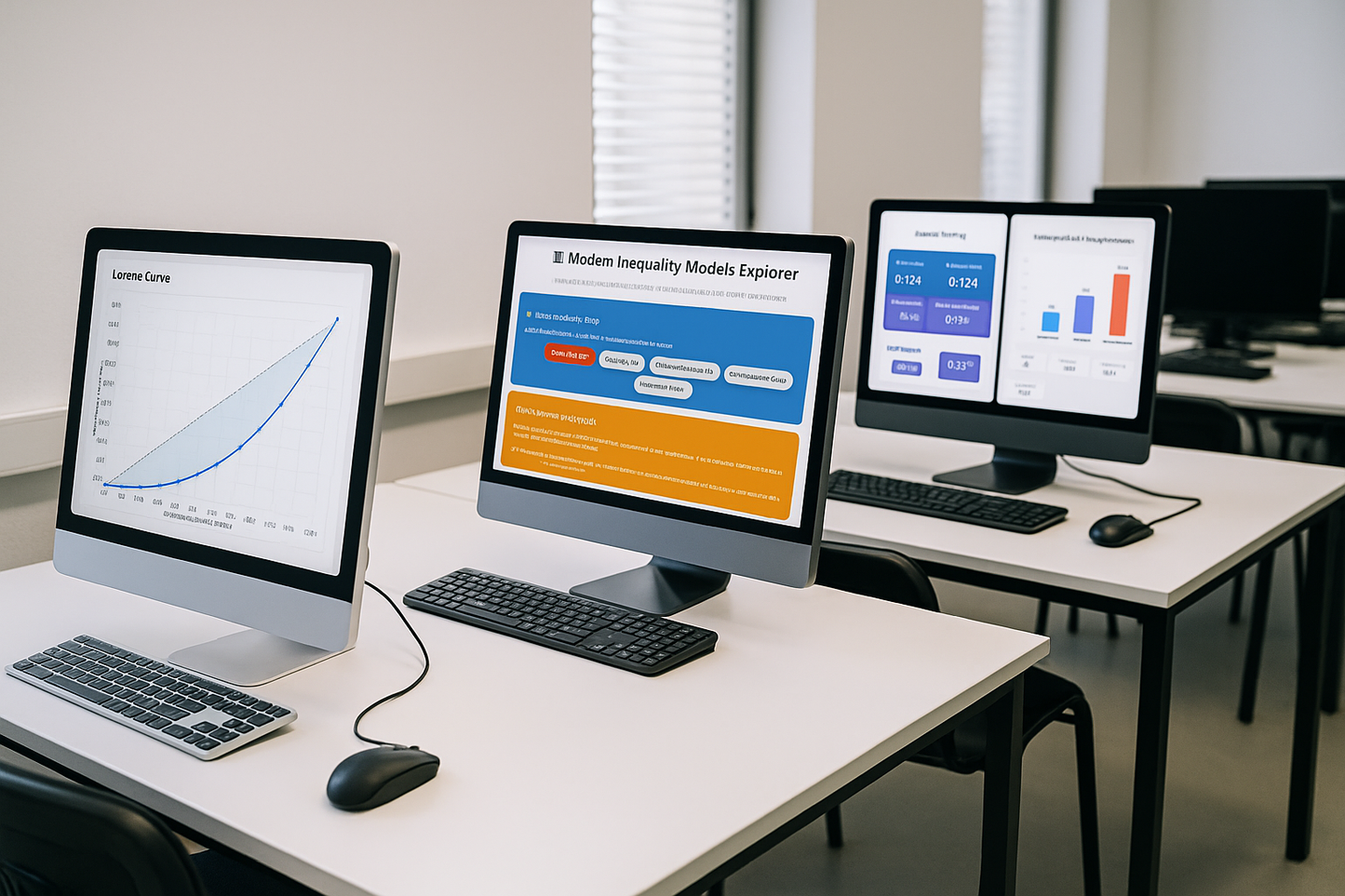BIZ-OMICS
Economics: Development Economics Interactive Lab
Economics: Development Economics Interactive Lab
Couldn't load pickup availability
This bundle is a set of classroom-ready HTML apps that turn abstract development models into vivid, hands-on learning. Students and teachers can tweak real parameters, see instant visual feedback, and link model mechanics to policies and outcomes, making “why it happens” as clear as “what happens.”
Lorenz–Gini Interactive Visualiser
A slick, decile-by-decile income editor with ready-made country presets, a live Lorenz curve, auto-calculated Gini, and a poverty-line headcount calculator lets learners connect distribution shapes to inequality metrics and poverty in seconds; it’s ideal for demonstrations, inquiry tasks, or assessment where students must justify which policy best shifts shares for the bottom deciles. Learners come away able to interpret Lorenz geometry, compute and compare inequality, test “what-if” redistributions, and explain the difference between inequality and poverty using their own parameter choices.
Modern Inequality Models Explorer (Kuznets Explorer)
This app puts competing theories side-by-side—from classic Kuznets and N-shaped patterns to Piketty’s r>g, tech-bias, globalization, and institutional quality—so students can vary GDP per capita, slide key parameters, overlay country paths, and trigger policy shocks to see why inequality rises, falls, or re-emerges. Learners finish with a comparative understanding of mechanisms behind inequality, can diagnose which theory fits a country’s trajectory, and can argue policy trade-offs with model-based evidence.
HDI Builder
A clean interface for the Human Development Index lets users set life expectancy, mean and expected schooling, and GNI per capita, while the tool computes each sub-index, the geometric mean, category bands, and surfaces tailored improvement suggestions and country comparisons. Students build fluency with HDI methodology, practice decomposition and sensitivity analysis, and justify priority reforms by showing how marginal changes in health, education, or income shift the overall index.
Harrod–Domar Growth Model Simulator
With sliders for savings, ICOR, depreciation, population growth, presets for “rapid,” “balanced,” and “poverty trap,” plus shock buttons for war, aid, technology, and crisis, this simulator animates the famous knife-edge instability and contrasts warranted, actual, and natural growth paths. Learners internalize the growth equation, detect instability conditions, and evaluate how policy or shocks move an economy toward or away from equilibrium, turning dense theory into memorable trajectories.
Dutch Disease Simulator
An intuitive dashboard lets you dial a resource boom, spending and movement effects, labour mobility, trade elasticity, export intensities, and a stabilization fund, then watch sectoral shares, the real exchange rate, export competitiveness, and fund size respond in real time. Students leave able to explain spending- and resource-movement channels, predict exchange-rate and tradables impacts, and defend the case for sovereign wealth funds with model-based reasoning
Poverty: Theory, Analysis and Policy
This immersive interactive resource provides an advanced exploration of poverty — defining, measuring, and analysing both absolute and relative dimensions through economic theory, global evidence, and applied policy analysis. Designed with clarity and depth, it guides learners through key concepts like the World Bank Poverty Line, the Multidimensional Poverty Index (MPI), and Gini Coefficient, supported by striking data visuals and contemporary case studies. Students can investigate real-world examples from Brazil, China, Sweden, the UK, and the USA, each illustrating how different policy frameworks affect poverty and inequality outcomes. The integrated scenario simulations allow users to apply theory to practice — testing fiscal and social policy decisions and seeing the outcomes unfold. With its clean design, dynamic interactivity, and synthesis of economic reasoning, this product transforms abstract theory into engaging, policy-relevant learning.
Economic Development & Inequality: Country Case Studies
A visually engaging and analytically rich study of how nations develop and distribute prosperity, this resource compares South Korea, Vietnam, and India through the lens of inequality and human development. Each country tab presents an immersive journey through its historical context, development strategy, and key policy innovations — from South Korea’s state-led industrial miracle and land reforms to Vietnam’s Doi Moi reforms and India’s post-liberalization challenges. Carefully structured sections integrate HDI data, Gini coefficients, poverty trends, and theoretical insights like the Kuznets Curve and Capability Approach, giving students a comprehensive understanding of development economics in practice. The sleek design and animated navigation make complex material accessible, while encouraging critical comparison between models of capitalist, socialist, and mixed economies. This resource is ideal for A-Level and university learners exploring how growth, equity, and governance interact in shaping global development trajectories.
Significance of Capitalism for Inequality
This thought-provoking digital resource examines the intricate relationship between capitalism and inequality, tracing how market systems generate both economic dynamism and social division. It situates capitalism within historical and theoretical frameworks — from classical liberalism and Marxist critiques to modern debates over neoliberalism, globalization, and state intervention. Through a blend of analytical commentary, case evidence, and comparative evaluation, it challenges students to consider whether inequality is an inevitable by-product of capitalism or a consequence of policy design and institutional structure. The product presents clear, well-organized sections on wage dispersion, wealth concentration, market failures, and policy reform, linking each to contemporary global examples. Designed for advanced learners in economics, politics, or sociology, it promotes evaluative thinking, encouraging students to interrogate capitalism’s evolving role in shaping global inequality across both developed and emerging economies.
Share


